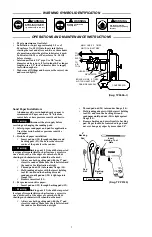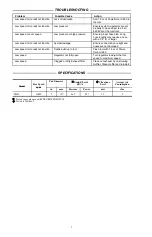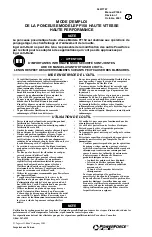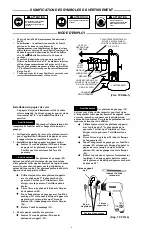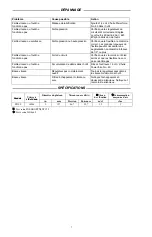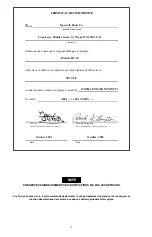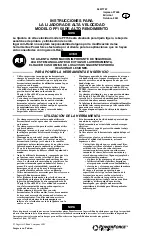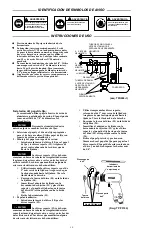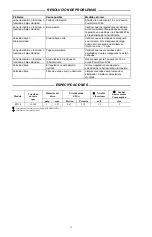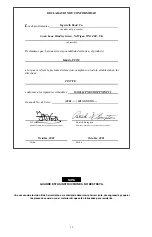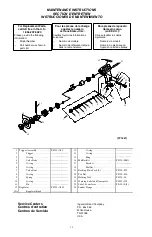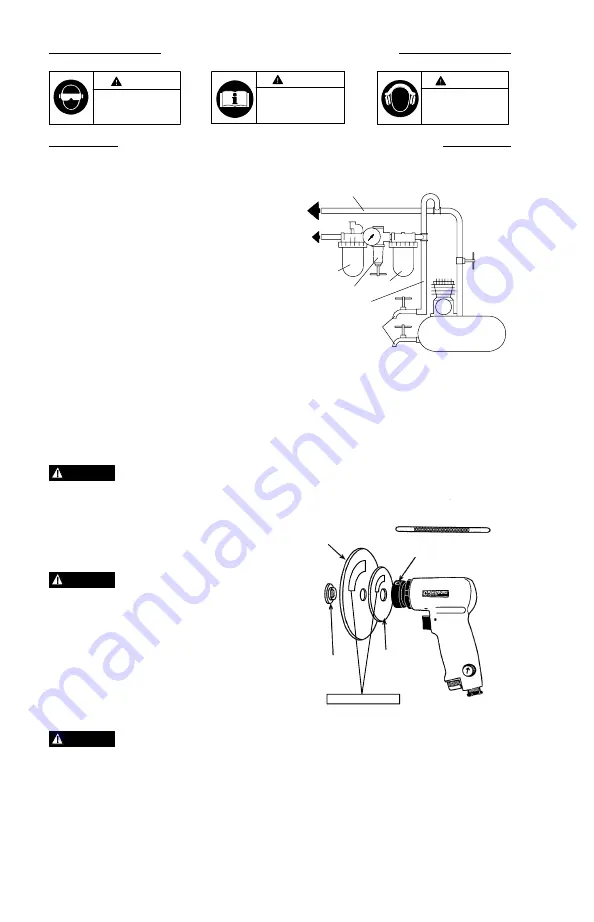
2
WARNING SYMBOL IDENTIFICATION
Always wear eye protection
when operating or perform-
ing maintenance on this tool.
WARNING
WARNING
Always wear hearing
protection when operating
this tool.
Read this manual before
operating tool.
WARNING
OPERATIONS AND MAINTENANCE INSTRUCTIONS
•
90 psig maximum at tool inlet.
•
Lubrication -- Inject approximately 1.5 cc of
Powerforce No. 50 Oil into the air inlet before
starting the tool and after each two or three hours
of operation, unless the air line lubricator is used.
Lubricate with 1.5 cc of Powerforce No. 50 Oil
before storage.
•
Inlet connection is 1/4” pipe. Use 3/8”
inside
diameter air hose up to 8 feet in length. For longer
lengths, use a 1/2”
inside
diameter hose to supply
tool with enough air.
•
Make sure all fittings and hoses are the correct size
and secured tightly.
MAIN LINES 3 TIMES
AIR TOOL INLET SIZE
TO
AIR
SYSTEM
TO
AIR
TOOL
LUBRICATOR
REGULATOR
FILTER
BRANCH LINE 2 TIMES
AIR TOOL INLET SIZE
DRAIN REGULARLY
COMPRESSOR
(Dwg. TPD905--1)
Sand Paper Installation:
Aluminum oxide, resin bond abrasive paper is
recommended. Paper can have 7/8” diameter
center hole or have pressure sensitive adhesive.
Warning
Disconnect the air supply before
servicing or changing the sanding pads.
1. Select proper sandpaper and pad for application.
Use either resin backed or pressure sensitive
sandpaper.
2. Resin back paper installation:
•
Insert pad nut (20) through sandpaper and
backing pads (19). Make sure the recessed
center of the pads face the sander.
Warning
Backing pads (19) should be inspected
for signs of irregularities such as fractures, excessive
wear, nicks, cuts, at the edges of center hole. Pads
showing such characteristics should not be used.
•
Always use both packing pad with the 3” pad
closest to sander. Make sure the label is toward
the sander. See illustration at right.
•
Thread pad nut (20) into sander flange (24).
•
Hold sanding adapter with the insert holding
tool (21) and turn the backing disc and
sandpaper until pad nut (20) is tight against
flange (24).
•
Remove insert tool (21).
3. For pressure sensitive paper:
•
Insert pad nut (20) through backing pads (19).
Warning
Backing pads (19) should be inspected
for signs of irregularities such as fractures, excessive
wear, nicks, cuts, at the edges of center hole. Pads
showing such characteristics should not be used.
•
Always use both packing pad with the 3” pad
closest to sander. Make sure the label is toward
the sander. See illustration at right.
•
Thread pad nut (20) into sander flange (24).
•
Hold sanding adapter with the insert holding
tool (21) and turn the backing disc and
sandpaper until pad nut (20) is tight against
flange (24).
•
Remove backing and press firmly to backing
pad. Paper should be centered onto pad and
not over hang any edges by more than 1/4”.
(Dwg. TP PF150)
5”
Backing
Pad
Insert
Holding Tool
Here
Pad
Nut
3”
Backing
Pad
HIGH
SPEED
LOW
SPEED
Faces Sander


